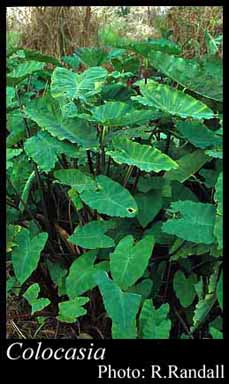- Reference
- Melet.Bot. 18 (1832)
- Name Status
- Current







Scientific Description
Family Araceae.
Habit and leaf form. Shrubs, or herbs; laticiferous. Herbs perennial. Leaves basal. Plants with a basal concentration of leaves, or with neither basal nor terminal concentrations of leaves; with an underground tuber or erect stem. Helophytic, or mesophytic. Heterophyllous, or not heterophyllous. Leaves medium-sized to very large; alternate; spiral, or distichous; petiolate (erect, long, stout, appearing conventionally ‘petiolate’ when the sheath shed); sheathing (the sheath membranous). Leaf sheaths with free margins. Leaves with ‘normal’ orientation; simple; peltate. Leaf blades pinnately veined, or palmately veined, or parallel-veined; cross-venulate; more or less cordate (and notched at base). Leaves ligulate, or eligulate. Axillary scales present, or absent. Leaves without a persistent basal meristem. Vegetative anatomy. Plants without silica bodies. Leaf anatomy. Guard-cells not ‘grass type’. Hairs absent. Stem anatomy. Secondary thickening absent. Roots. Roots with velamen, or without velamen.
Reproductive type, pollination. Fertile flowers functionally male and functionally female. Unisexual flowers present. Plants monoecious. The unisexual flowers aggregated in different parts of the same inflorescence. Anemophilous, or entomophilous. Pollination mechanism conspicuously specialized, or unspecialized.
Inflorescence and flower features. Flowers aggregated in ‘inflorescences’; in spikes. Inflorescences usually paired. The terminal inflorescence unit seemingly racemose. Inflorescences scapiflorous, or not scapiflorous; consisting of specialised spikes (‘spadices’), spadix densely flowered, with the naked female flowers below, then a zone of tubercular sterile flowers, then a zone of polygonal male flowers, appendix reduced or absent; pseudanthial; spatheate (spathe erect, convolute, constricted; basal portion an inflated closed sheath, with overlapping margins, thick, persistent; distal portion an expanded blade, eventually shed). Flowers ebracteate; ebracteolate; small (numerous); (these or the spadix) fragrant, or malodorous; cyclic. Perianth absent. Fertile stamens present, or absent (when female). Androecium 3. Androecial members coherent (forming a stout column); 1 -whorled. Androecium exclusively of fertile stamens. Stamens 3. Anthers cohering; basifixed; non-versatile; dehiscing via pores, or dehiscing via short slits, or dehiscing via longitudinal slits, or dehiscing transversely; extrorse; bisporangiate, or tetrasporangiate. Pollen shed in aggregates, or shed as single grains. Fertile gynoecium present, or absent (when male). Gynoecium 1–3 carpelled. The pistil 1 celled. Gynoecium monomerous, or syncarpous; of one carpel, or synstylovarious to eu-syncarpous; superior. Carpel apically stigmatic. Ovary unilocular; 1 locular. Gynoecium shortly stylate, or non-stylate. Styles apical. Stigmas wet type, or dry type; non-papillate; Group II type. Placentation parietal. Ovules in the single cavity 15(–50) (i.e. ‘many’); pendulous, or horizontal, or ascending; in 2–4 rows; orthotropous, or hemianatropous, or anatropous.
Fruit and seed features. Fruit fleshy; red; indehiscent; a berry. Dispersal unit the fruit, or the inflorescence. Seeds endospermic. Endosperm oily (and starchy). Perisperm absent. Seeds with starch. Cotyledons 1. Embryo straight (linear). Seedling. Hypocotyl internode present, or absent. Mesocotyl absent. Seedling collar not conspicuous. Cotyledon hyperphyll compact; assimilatory, or non-assimilatory. Coleoptile absent. Seedling non-macropodous. First leaf dorsiventral. Primary root ephemeral.
Physiology, biochemistry. Photosynthetic pathway: C3.
Geography, cytology, number of species. Native of Australia. Not endemic to Australia. Australian states and territories: Western Australia, Northern Territory, Queensland, and New South Wales. Northern Botanical Province and South-West Botanical Province.
Economic uses, etc. C. esculenta (‘taro’) widely cultivated for its starch-rich tuber.
Taxonomic Literature
- Wheeler, J. R.; Rye, B. L.; Koch, B. L.; Wilson, A. J. G.; Western Australian Herbarium 1992. Flora of the Kimberley region. Western Australian Herbarium.. Como, W.A..